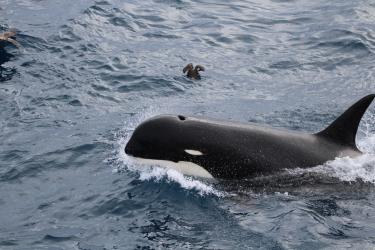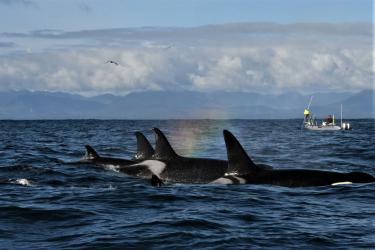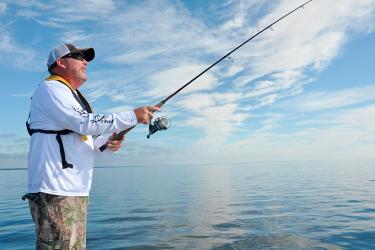
In 2015, NOAA Fisheries launched the agency-wide Species in the Spotlight initiative to bring attention to the recovery of eight highly at-risk species through strategic actions and expanded partnerships. The Species in the Spotlight heroes are partners who have gone beyond the call of duty to help recover these species—taking on tasks from matchmaking to administering vaccinations.
This group of highly skilled and motivated individuals demonstrates that successful species recovery requires heroes of all kinds. With the dedicated efforts of our heroes and many public and private organizations, we can make sure that endangered species move forward from “survive to thrive.”
Meet Our Recovery Heroes
Jeff Hogan spends his days toting a casting of a killer whale skull from classroom to classroom, teaching kids about whales in the wild and how they can help conserve them. Since the program’s inception, Hogan and the Killer Whale Tales program have reached more than 120,000 students from California to Washington.

“The kids’ willingness to [say] ‘Okay, we see a problem, we’re going to solve it.’ That’s by far the best part. I get goose bumps just thinking about it.” - Jeff Hogan, Killer Whale Tales.
Andy Goode has been a leader in negotiating dam removals throughout the state of Maine. He worked with the community to negotiate the removal of Coopers Mills Dam, and helped balance the cultural significance of the dam and community needs with the restoration of habitat connectivity for Atlantic salmon.

“Individually, these projects don't make a big difference. But when you start collectively doing a lot of them, like the 20 we've done, we think it has a measurable biological impact.” - Andy Goode, Atlantic Salmon Federation.
Dr. Kristin Aquilino has become a matchmaker for white abalone. She has facilitated successful spawns of the species in captivity (sometimes even coaxing them with romantic music), and through close collaboration with partners, figured out how to get thousands of baby white abalone through the toughest time of life—the first year. The growing number of captive-bred white abalone are destined for rebuilding populations in the wild as part of the larger white abalone recovery implementation effort.

“Few things bring me more joy than showing someone the beady, black eyes topping the mollusk's long, skinny eyestalks. They have faces! They move! Did I mention that they're adorable?!” - Kristin Aquilino, UC Davis Bodega Marine Laboratory.
Lewis Bair helped secure funding for and spent countless hours coordinating two major projects that will improve the survival of Sacramento River winter-run Chinook salmon. Reclamation District 108 contributed approximately $500,000 to the permitting and design of one of these projects, and Bair engaged key partners to fund and implement both.

“There is growing hope in our community that hard work and strong partnerships will bring sustainability to both California’s fish and farms.” Lewis Bair, Sacramento Valley Salmon Recovery Program.
The Ke Kai Ola Marine Mammal Center has been instrumental in Hawaiian monk seal recovery, including rehabilitating and releasing 21 seals since the facility opened in 2014. Four more seals were released this past summer. Overall, the center has rehabilitated about 2 percent of the population. The Ke Kai Ola Marine Mammal Center also helped with the initial stages of the morbillivirus vaccination program.

“Now [the seals] have a place to come to. We can take care of them and give them a second chance.” – Deb Wickham, Operations Manager for Ke Kai Ola Marine Mammal Center.
The Cook Inlet Beluga Conservation Program team at the Joint Base Elmendorf-Richardson has been a valuable partner in helping conserve Cook Inlet beluga whales. The team engages in research and conservation activities that implement many of the priority actions identified in the Species in the Spotlight Action Plan. Their sharing of data, resources, and even video footage of the whales, has significantly contributed to NOAA Fisheries’ understanding and conservation of Cook Inlet beluga whales.

“We gladly accept this award [Recovery Hero Award] and do so with the full realization there was a whole group of people who helped us get to this point.” – Chris Garner, biologist with the Cook Inlet Beluga Conservation Program at Joint Base Elmendorf-Richardson.
Dr. Brian Dietterick has advanced restoration and recovery efforts for Central California Coast coho salmon at the southern extent of their range. He has mentored graduate and undergraduate students on coho salmon conservation and has been a vital partner in forging relationships with private landowners. He and his colleagues have also collected and shared data in support of the Central California Coast coho salmon federal recovery plan, supported the conservation hatchery program by hosting meetings and field tours for the Scott Creek Lagoon restoration project, and conducted high-priority, multi-year restoration projects on the Swanton Pacific Ranch.

"Their [Central California Coast coho salmon] chances for survival, as it relates to physical habitat conditions, have dramatically increased through a number of projects in the Scotts Creek watershed. We are proud of these efforts and personally, I am honored to have been recognized as one contributor to this Cal Poly effort." - Brian Dietterick, California Polytechnic State University, College of Agriculture, Food, and Environmental Services.
The State University of Papua (UNIPA) has been engaged since 2005 in recovering the last and largest-remaining leatherback nesting population in the Pacific, which nests on Jamursba Medi and Wermon Beaches on the remote Bird’s Head Peninsula in Papua-Barat, Indonesia. UNIPA has worked at “ground zero” for leatherback conservation in the Western Pacific, including surveillance of nests to deter predators. UNIPA has also worked to gain the trust of local communities and engage them in the conservation effort.

“We began working with one of the three villages by the nesting beaches. …We want them [the community] to be able to protect the leatherback themselves one day.” - Fitryanti Pakiding, researcher and lecturer at the State University of Papua (UNIPA).



